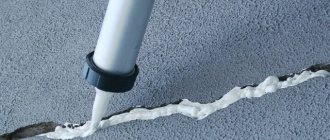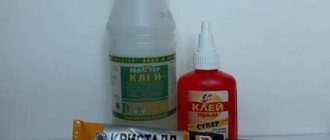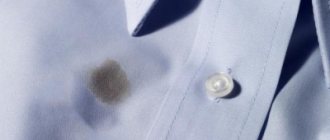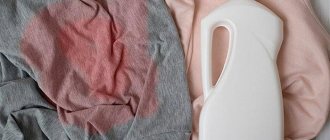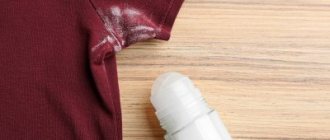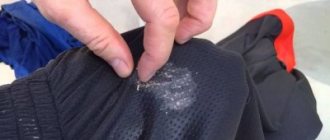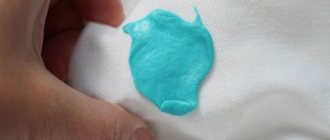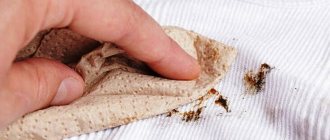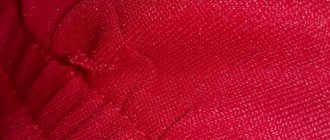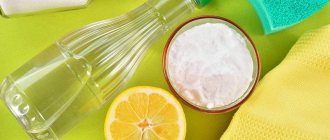Stained clothes and shoes are not uncommon when using building mixtures. As a rule, this does not happen during large-scale installation work, but during minor repairs. Rarely does anyone purchase workwear for one-time use of a polyurethane composition. How to remove polyurethane foam from clothes, and what is better not to use, we will consider in the article.
Basic Rules
Before using any of the cleaning methods below, you must ensure that they will not harm your clothing. Most often, work clothes made from thick cotton-based fabrics are stained with foam. Such fabrics are quite resistant, so various solvents can be used on them.
It is much more difficult to cope with the task if the foam gets on delicate materials - fur, suede, silk. Such fabrics require especially careful handling, so it is very difficult to remove foam from them. Thus, exposure of silk or wool to organic solvents can destroy the fibers or discolor the dyes, forming a whitish spot on the fabric. It is better to dry clean clothes made from delicate fabrics.
How to avoid foam getting on clothes
Carrying out any work using installation composition requires wearing protective equipment. It is best to cover your clothes with a special disposable plastic cover. It is quite possible to put on a cover for things, but you will first have to cut through the sleeves. Even a regular rough apron will do, but it does not provide reliable protection against sealant ingress. Don't forget to wear gloves. Washing off foam from your palms is sometimes no easier than removing sealant from your favorite clothes.
Prohibited Methods
Not all common solvents help remove traces of construction foam. Their use will not only not clean, but will also make the stain even more persistent.
Cannot be used:
- Water. Always try to wash off any stains with water first, since water is a universal solvent. However, polyurethane foam is an exception. The substance has a porous structure, actively absorbs water and penetrates even deeper into the fibers of the fabric.
- Heat. When heated, the foam becomes more viscous and penetrates deeper into the material, enveloping the fibers.
- Peroxide solution . This substance reacts with the ingredients in the foam, making stains even more difficult to remove from clothing.
- Vinegar essence. This product copes well with many stains, but does not help remove foam. But it can ruin the fabric.
- Unrefined gasoline. We are talking specifically about unrefined fuel; this substance can leave stains on the fabric that will be even more difficult to remove than washing off the foam.
General recommendations
Almost everyone who is faced with the problem of how to wash foam from clothes, thinking that it is impossible to do, throws away the damaged item. However, you can get rid of persistent marks if you choose the optimal method for this.
To ensure effective and safe cleaning of the material, consider the following recommendations:
- There is no need to wash the foam and leave the stained item in water for a long time. The water temperature will gradually decrease, which will lead to rapid hardening and hardening of the foam. After this it will be much more difficult to clean it.
- Before cleaning the fabric, pay attention to its type, composition and care instructions indicated on the label.
- When working with solvents, be sure to wear protective gloves and a mask to protect yourself.
- Start working with foam as early as possible, before it hardens. Using a knife, blade or other object, remove excess foam from the surface, moving from its edge to the center, trying not to smear the stain.
Professional products
Stain removers will not help in this case; you need to use special solvents. This may be a liquid intended for washing mounting guns or a foam solvent in the form of a spray.
Gun cleaning fluid will help remove fresh foam. Procedure:
- still soft foam must be immediately removed from clothing using a spatula or just a piece of cardboard;
- you need to try to remove as much of the substance as possible, so that later it is easier to eliminate the remains;
- you need to clean carefully, from the edges to the center, otherwise you can simply smear the foam over the surface, increasing the area of contamination;
- take a piece of white, clean cloth, moisten it with gun cleaning fluid and wipe off the stain;
- send clothes to the wash, you can wash them in a machine or by hand; when washing by machine, it is recommended to use the soaking and additional rinsing mode.
Liquids for washing the gun are produced in the form of a liquid, as well as in the form of impregnated wipes. The latter option is very convenient for cleaning fresh stains from clothes.
It should be taken into account that the substances contained in the solvent can damage the fibers of the fabric or change its color. Therefore, you first need to evaluate its effect on the fabric by dropping it on the hem of the bottom or in another place that is not obvious.
It is somewhat more difficult to wipe off dried foam. A foam solvent is suitable for solving this problem. It is more effective, but also more aggressive than gun wash.
First you need to try to remove the maximum amount of foam mechanically. If the layer is thick, you can try to cut it off with a knife; if the layer is thin, remove it with a nail file. But these methods are not suitable for thin and delicate fabrics.
Then you need to spray the solvent directly onto the stain and leave for about half an hour, then carefully wipe off the remaining foam. Then wash the item in the machine.
The following solvents can be used to remove foam:
- Liquid for washing construction guns . Sold in 0.5 liter aerosol cans.
- Makroflex Premium. Removes fresh stains well, sold in 0.5 liter aerosol cans.
- Grover Cleaner and Grover Remover. The first option is ideal for removing fresh stains. The second product is more expensive, but it will also cope with dried stains. Suitable not only for fabric, but also for leather.
- Available in two types . The spray removes fresh stains well. The product in the form of a paste copes with old stains.
You can use other foam solvent options.
Watch the video
Today there are many videos on the Internet that clearly show how this or that method works. As a result of viewing, you can create a more complete picture of how everything should be carried out.
Here you can consider in detail what tools you will need, what methods work and what don’t, which will help you deal with the problem more effectively.
It is possible to clean clothes from polyurethane foam after repair work. The main thing is to try and choose the right remedy that will solve the problem faster. When working with most of them, it is imperative to follow safety rules - avoid contact with skin, inhalation of vapors, etc. To avoid such situations, it is recommended to use respirators and gloves and wash your hands thoroughly after handling.
Physical methods
Physical methods for removing traces of polyurethane foam are safe for fabric. Two methods can be used:
- Freezing. Place the affected clothing in a plastic bag and place it in the freezer for several hours. You need to make sure that the stained area remains on top. After freezing, the foam becomes more brittle; it is cleaned mechanically.
- Ultraviolet. The sun's rays destroy the polyurethane foam, however, destruction will take a lot of time. The method is simple. The clothes are laid out so that the soiled area receives direct sunlight. You will have to keep your clothes in this place for several days. Once a day you will need to approach the item and clean the surface, removing destroyed particles of foam. The method is not suitable for colored fabrics that may fade in the sun.
However, physical methods rarely help to completely get rid of traces of foam on clothing. Usually, after their use, it is necessary to additionally use chemical cleaning methods.
Features of removing polyurethane foam from clothes
Since the main feature of polyurethane foam is the fact that it perfectly penetrates into the most inaccessible places and quickly sets on the surface, getting it on clothes and drying entails a number of difficulties in eliminating such contamination. Simple washing and the use of stain removers in this case are ineffective.
Once the polyurethane foam sealant gets on the fabric, it becomes extremely difficult to wipe it off. Therefore, most often it is necessary to use very aggressive cleaning methods.
We recommend reading: How to remove brilliant green from linoleum
Available means
If you don’t have a special solvent at home, you can remove the foam from the fabric at home using what you have on hand.
Oil
To remove a fresh stain, you can use any vegetable oil; you need to choose a refined, odorless product.
Procedure:
- heat the oil until hot;
- remove the maximum amount of foam mechanically;
- pour oil onto the contaminated area;
- then wash with hot water using dish gel, the gel will help remove oil traces.
This method is not suitable for fabrics that cannot be washed at high temperatures, that is, for synthetics and delicate natural materials.
Dimexide
This is a pharmaceutical product for external use, used to treat injuries and diseases of the joints. The medicine will help remove even dried foam.
Procedure:
- we clean the foam mechanically, removing as much of the substance as possible;
- apply dimexide to the stain: you can simply pour the liquid from a bottle or soak a cotton swab with the medicine and apply it to the stain;
- leave for half an hour;
- Clean the clothes with a brush, removing any remaining foam from the fabric.
After this treatment, you need to wash the item.
Petrol
You need to use purified gasoline; you can buy fuel for gasoline lighters. To remove traces of polyurethane foam, you need to proceed as follows:
- remove the maximum amount of foam mechanically;
- moisten a white cotton cloth with gasoline;
- apply it to the area of contamination for 20 minutes;
- remove the cloth, wash the treated area with warm water and laundry soap;
- wash the item completely in the machine or by hand.
When washing, it is recommended to use conditioner and add an extra rinse. Dry in the open air to remove the smell of gasoline. Acetone or white spirit can be used similarly.
So, cleaning polyurethane foam is not very easy. But there are still ways to remove traces of this building material from clothing. It is advisable to remove fresh stains, since dried stains are much more difficult to remove.
Foam Solvent
It turns out that in some hardware and construction stores you can find a product that is specifically designed for removing dried polyurethane foam. It’s called a PU foam cleaner. It is somewhat similar in its properties and action to the cleaner for mounting guns, but is considered more effective. What need to do. First, carefully clean off the top layer of dirt, then treat the area where the stain remains with this product and wait 20 minutes.
Tip: Each product has instructions for its use. We advise you to always follow the manufacturer's recommendations.
Scrub any softened foam residue with an old toothbrush or stiff sponge. If necessary, the procedure can be repeated. At the end of cleaning, it is better to wash the item completely.
Toxic substances and rules for working with them
When cleaning sealant, you will have to work with toxic substances that are harmful to human health. Therefore, when using such products, follow the instructions:
- When using chemicals, ventilate the room.
- Be sure to wear gloves before working with toxic substances. This will protect your hands from chemical burns.
- When using chemicals, use a respirator; if you don’t have one, wear a gauze bandage. This will protect you from inhaling harmful fumes.
- Do not use chemicals near open flames.
- Place a scarf on your head. Getting the product on your hair can damage it.
These tips will help you remove sealant not only from clothes, but also from walls, furniture, and floors. For this you do not need dry cleaning; all necessary manipulations are carried out at home.
Why is it so hard to scrub off?
Polyurethane foam TYTAN LEXY 20 300 ml. Photo by Maxidom
Foam is a polyurethane sealant that contains a significant amount of chemicals: stabilizers, catalysts, thickeners, isomers. As a result, foam is difficult to remove from clothes and shoes (and other surfaces as well) for several reasons:
- Expansion of the mixture. When the composition leaves the aerosol can, the foam begins to actively expand due to the presence of gas in the composition. Once on clothing, the foam continues to expand for some time, simultaneously penetrating the fabric structure. Even low expansion foams are difficult to remove from fabric.
- Fast curing. Quick drying, which takes an average of 15-30 minutes, makes it much more difficult to remove contaminants.
- Tissue damage. Removing the stain is not the only task. It is also necessary to avoid damage to the fabric fibers, deformation of the item, and changes in the color of the clothing. But this is not always possible to achieve. Therefore, you need to know the recommendations that will help you avoid getting foam on your hands and clothes.
Chemicals for cleaning sealant
Any hardware store sells a special cleaner for sealants. It is inexpensive, but it effectively helps against stains from polyurethane foam and any other sealant. Cleaning instructions are simple:
- Remove sealant from clothing as much as possible.
- After this, apply a thick layer of cleaner and let it sit for 40-50 minutes.
- When the time is up, brush the material.
- As a result, all you have to do is wash off the remaining foam and wash the item in a soapy solution.
Should I clean or use protective equipment in advance?
Formally, according to safety precautions for working with substances potentially harmful to humans, you should work with polyurethane foam using gloves, protective clothing, goggles and a respirator. These recommendations, like any other TB rules, are quite fair. And polyurethane foam is not very useful for the skin, and it has a specific smell, and it can get into your eyes. However, safety precautions, as always, do not take into account the convenience of working in protective clothing and the fact that sometimes the operation is carried out very quickly, literally “on the go”, and there is simply no time/desire/opportunity to look for suitable clothing, goggles, a respirator and gloves. Well, don’t forget about the tendency of our compatriots to neglect safety measures.
However, we still strongly recommend:
- hide hair under a cap, headband or other headdress. If the foam can still be removed from the skin, then the hair does not have to be cut into clumps. This is especially true for lovers of long hair;
- wear clothes that you don’t mind getting dirty and/or thrown away. The sleeves and legs are long, the body is as closed as possible. In the summer it is, of course, hot to work in such uniforms, but you will have to wash less after repairs;
- choose gloves that fit your hand exactly. Large ones will slip and get in the way, small ones will interfere with your work and can put too much pressure on your brushes. It is better to take rubberized textile or old leather ones. Ordinary rubber household ones, or even more so disposable medical latex ones, do not protect hands well.
A respirator is recommended as a mandatory protective measure for allergy sufferers, as well as if it is impossible to organize ventilation in a closed room. Glasses are necessary - really necessary! – when working with polyurethane foam on the ceiling and any surfaces higher than the worker’s height.
Sometimes it is advised to lubricate your hands (without gloves, of course) with vegetable oil or Vaseline before starting work. Well, we can only admire those who manage to hold a foam container and a gun with greasy hands and not “paw” all the surrounding objects. The rest will quickly go to wash the skin of grease and clean the instrument.
